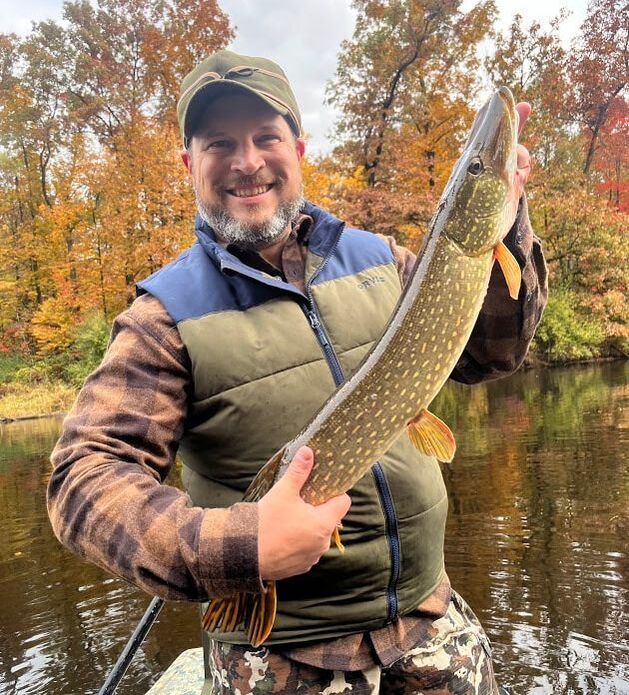|
By Drew YoungeDyke (Originally published in the January 2021 issue of Woods-N-Water News)
Throughout 2020, outdoor recreation has provided a welcome outlet for cooped-up Michiganders as a safe, healthy, and fun way to maintain social distancing. The arrival of snow and cold weather doesn’t have to stop that trend. Cross-country skiing is a fun way to enjoy the snow while staying in shape and breaking cabin fever. Cross-country skiing is the simplest form of Nordic skiing, which also includes backcountry touring and skate-skiing like you might see in the Winter Olympics. In classic cross-country skiing, you ski in tracks on relatively flat terrain. Many metroparks, state parks and forests, and even golf courses in Michigan offer tracked cross-country ski trails, and in light conditions it doesn’t take much to create new tracks on nature area trails throughout Michigan. I started cross-country skiing when I was four years old as my parents took me for short trips in the woods behind the school and baseball field in my northern Michigan hometown of Central Lake. In high school I spent more time downhill skiing than cross-country, but I picked it back up on winter breaks home from college. That had as much to do with college finances as anything: I didn’t need a lift ticket to cross-country ski, just a trail and a hill. Now you can find trails on the Michigan Department of Natural Resources website under “Things To Do/Winter Sports/Cross-Country Skiing”. You can really cross-country ski anywhere there’s enough snow; I even ski into work when there’s fresh snow on unplowed side streets, un-shoveled sidewalks, and through nature area trails between my house and our National Wildlife Federation office in Ann Arbor (at least I did before we started remote working due to COVID-19 last March). What I love about cross-country skiing is finding the rhythm that makes the stride smooth and comfortable. The basics of sliding on skis in a straight line are pretty simple, but when I can kick up and find a good rhythm I feel like I’m gliding across the snow like my Iron Age Finnish ancestors might have done – skis and petroglyphs depicting skiers have been found in Finland dating back at least 5,000 years! My skis aren’t quite that old (though at 25 years they sometimes seem like it) but they were made in Finland. Beyond the fun feeling of gliding across the snow, cross-country skiing has some serious health benefits. There’s a reason Nordic Track made a lot of money in the 1980’s selling a home workout apparatus that tries to mimic cross-country skiing. The real thing is a total body workout burning 544 to 816 calories per hour for people with body weights of 150 to 225 lbs., respectively, according to LiveStrong.com. In the winter I’ll often substitute my 5K trail runs for a 5K ski. This winter I may also add resistance to the workout by towing my toddler son behind me in a sled. To get started, you might begin with classic skis, which are more forgiving and used for gliding in a relatively straight line, as simple as walking or running. Performance, metal-edged, and skate skis are more advanced options for speed, off-trail touring, and skate-skiing, respectively. Several state and local parks, as well as ski and outdoor shops offer ski rentals. If you’re new to cross-country skiing, you might want to rent skis a few times before buying. REI has an excellent buyer’s guide to cross country skis on www.rei.com. Used skis are another option; as I wrote earlier, I’ve had my waxless Karhu skis for 25 years (they’re not for sale, though). Selecting the right clothing for active winter sports can be tricky. You want to protect against the cold and snow, but you’re going to work up a sweat. I like to use a merino wool base layer paired with a waterproof or water-resistant shell and mid-layer insulation matched to the conditions. On warmer days, that might mean a light merino wool base layer, Prana Zion pants with gaiters over my ski boots, a fleece pullover, a merino wool hat, and gloves. On colder days, I might add snowboard pants and a light packable down jacket, stored in a light backpack with extra gloves. If you’re new to cross-country skiing, you may fall down more often and want something that repels snow better. To ski, think of it just like walking. Stick to open, flat trails at first – if you lose control going downhill in the woods, those trees can be dangerous. Wedge your skies to walk up steeper ascents. It might be awkward at first, but like every athletic activity, it helps to keep some bend in your knee and work from your core outward to your extremities. By the time you’re done, you’ll feel it throughout. To make a day of it, especially with the family, prepare to have some hot chocolate when you return. Sitting by a fireplace to warm up while you dry out feels great, and it would be even better to have a hot sauna ready to go if you have the means. We’ve all been more cooped up than normal over the past year, and our collective cabin fever will only get worse this winter unless we deliberately seek and find ways to break it. Cross-country skiing can do that while also providing a great workout and a lifetime of relatively inexpensive winter weekend fun. |
AUTHOR
Drew YoungeDyke is an award-winning freelance outdoor writer and a Director of Conservation Partnerships for the National Wildlife Federation, a board member of the Outdoor Writers Association of America, and a member of the Association of Great Lakes Outdoor Writers and the Michigan Outdoor Writers Association.
All posts at Michigan Outside are independent and do not necessarily reflect the views of NWF, Surfrider, OWAA, AGLOW, MOWA, the or any other entity. ARCHIVES
June 2022
SUBJECTS
All
|



 RSS Feed
RSS Feed